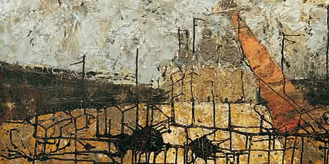
In the early 1950’s, Naples and New York disappeared from Congdon’s geographical and emotional horizons and Venice emerged. Venice seduced him with its pure beauty, made of water and light. The splendor of Venice dazzled him like a promise. In the many paintings of St Marks Square, the black stain of New York City (Explosion) gave way to the disc of light that first appeared in New York, the ‘disc of gold’.
Peggy Guggenheim praised Congdon’s work declaring it as good as the old masters’. Congdon’s fame grew and gave him access to the sanctuaries of American culture. Travel and flight from self continued to be structural elements of his technique. After four intense years of passion, his romance with Venice also came to an end.
In 1951 his wanderings took him to Assisi. In the city of St Francis he met Don Giovanni Rossi, founder of Pro Civitate Christiana, a missionary association that attracted many artists from various countries. This meeting awoke in him the need for a profound conversion, which nevertheless he put off for many long years of traveling and escape.
Painting frantically Congdon pushed himself to the brink of the abyss and this led him to the absolute void of the Sahara desert; of the island-volcano of Santorini; of the dead vultures in Guatemala, the ruins of Cambodia, and the stations-abyss of the Paris metro. Death also lurked in the murky colors of his new series of Exeter winter paintings, with which in 1956 Congdon took leave of his own country, which he felt had definitively and finally rejected him.
Nine years later, in 1959, William surrendered to the Catholic Church and was baptized in the Basilica of Assisi. Congdon moved to Assisi on Don Giovanni’s invitation and there he made his home for about twenty years, although he continued his frequent comings and goings.